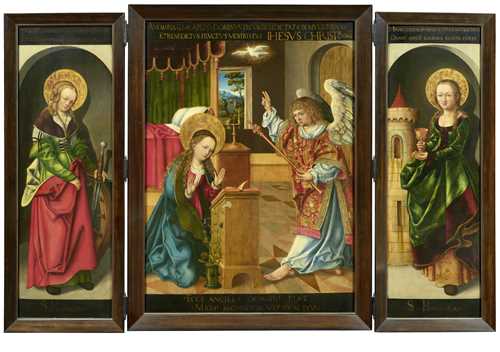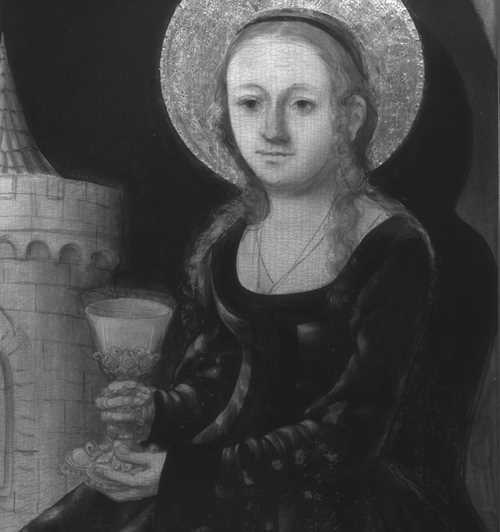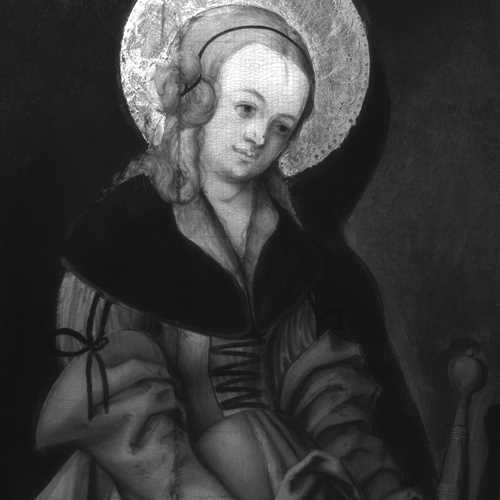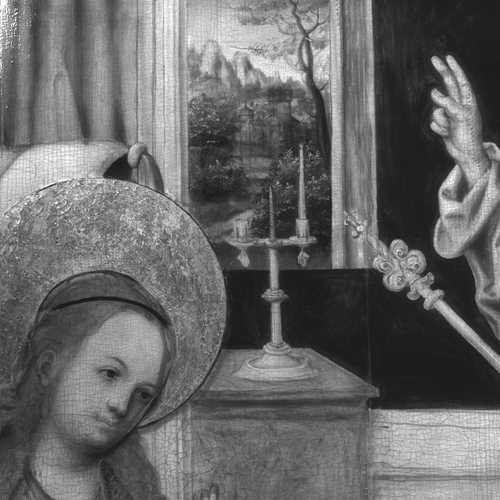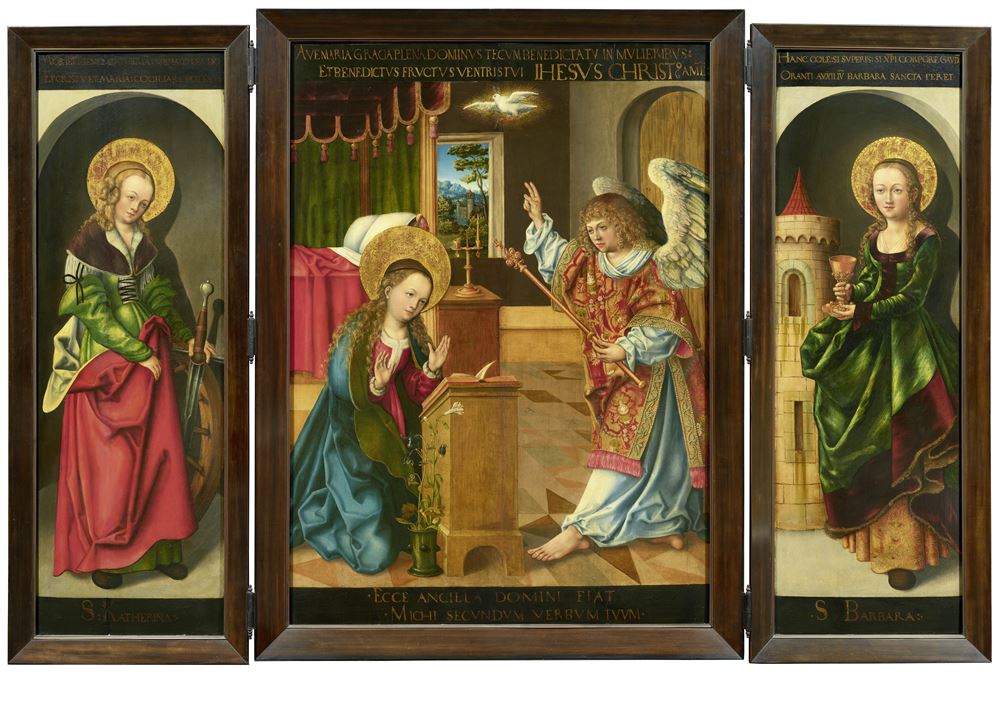
拍品 3014 - A204 大师画作 - Freitag, 31. März 2023, 02.00 PM
LUCAS CRANACH the Elder and Studio
(Kronach 1472–1553 Weimar)
Winged altarpiece with the Annunciation, Saints Catherine and Barbara (inside), as well as Christ as Man of Sorrows and Mary as Mother of Sorrow (outside). Circa 1515.
Oil on panel.
The central panel inscribed above: AVE MARIA GRACIA PLENA DOMINVS TECVM BENEDICTA TV IN MVLIERIBVS: ET BENEDICTVS FRVCTVS VENTRIS TVI IHESVS CHRIST(VS) AME(N) and inscribed below: ECCE ANCILLA DOMINI FIAT MICHI SECVNDVM VERBVM TVVM.
Left wing inscribed above: MORIB I(N)GENIO CATHERI(N)A:STEMATE FELIX: / ET CRISTV ET MARIA:COCILIARE POTEST: and inscribed below: S:KATHERINA.
Right wing inscribed above: HANC COLE:SI SVPERIS:SI XPI CORPORE GAVD / ORANTI AVXILIV BARBARA SANCTA FERETand inscribed below: S BARBARA.
Left wing inscribed above: MORIB I(N)GENIO CATHERI(N)A:STEMATE FELIX: / ET CRISTV ET MARIA:COCILIARE POTEST: and inscribed below: S:KATHERINA.
Right wing inscribed above: HANC COLE:SI SVPERIS:SI XPI CORPORE GAVD / ORANTI AVXILIV BARBARA SANCTA FERETand inscribed below: S BARBARA.
Central panel: 122.5 × 86 cm. Lateral wings: 120.5 × 37.5 cm each.
Provenance:
- With Galerie Miethke, Vienna.
- Sale Stuker, Bern, 1972.
- Private collection, Switzerland.
This work, one of the last surviving altarpieces of the German Renaissance, is on offer here as a masterpiece by Lucas Cranach the Elder and his workshop. Privately owned for half a century, this monumental work of art was recently discovered in a Swiss private collection and is now being offered again on the art market. The museum quality of this piece is very much apparent in the luminous colours and virtuoso detail. Created in the artist's Wittenberg phase around 1515, during which Lucas Cranach the Elder was active at the electoral court of Frederick the Wise (1463–1525), this triptych superbly demonstrates the artistic virtuosity of this master and his workshop.
When opened out, the altarpiece shows the Annunciation of Mary in the central panel, flanked on the wings by Saints Catherine and Barbara. The two saints are depicted as full figures standing in niches indicated by the round arches in the upper part. They reveal their identity through their respective attributes: Catherine with the sword and wheel, Barbara with the tower in which her father had imprisoned her. The spatial arrangement of the lateral wings gives no indication of the location. The central panel, on the other hand, suggests a palatial room which, with its tiled floor shown in perspective and its furnishings, has a homely character. Mary is to be found kneeling at a prie-dieu, an open prayer book before her, and is greeted from the right by the Angel of the Annunciation and the dove of the Holy Spirit hovering over him. Next to Mary's prie-dieu is a glass vase with the classic Marian symbol of a lily with three buds, as well as a columbine with three blossoms, symbolising the Trinity. On the back wall of the room, slightly off the central axis, there is a window looking out on a landscape with a castle surrounded by water, trees and a mountain range in the background. The backs of the lateral wings, which can be viewed when closed, show the Man of Sorrows on the panel with Saint Catherine and the Mother of Sorrows on that of Saint Barbara, both facing each other. Both outer wings are characterised by a monochrome dark background without any spatial reference.
The Latin inscriptions can be translated as follows:
Central panel: Annunciation of Mary (in reference to the Hail Mary, Lucas 1:28).
Hail Mary, full of grace, the Lord is with thee, blessed art thou among women, and blessed is the fruit of thy womb, Jesus Christ. Amen.
Behold, I am the handmaid of the Lord, let it be done to me according to your word.
St Catherine (left wing):
Through her virtue and keen understanding she has attained honour; she is happy in Christ and Mary.
St. Barbara (right wing):
In devotion to the saints and to the body of Christ, joy is granted to those who pray; St Barbara grants him aid.
While Max Friedländer and Jakob Rosenberg were not yet familiar with this altarpiece (Max Friedländer and Jakob Rosenberg: Die Gemälde von Lucas Cranach, Berlin 1932/ Basel 1979), the central panel and the wings were until now listed individually in the databases ‘lucascranach.org’ and ‘CORPUS CRANACH’ with no mention of a connection between them. Dr Dieter Koepplin, whom we thank for his information, describes the work overall as ‘a high-quality, extremely diligently executed work from the early Cranach workshop around 1515’. The qualification ‘Lucas Cranach the Elder and Workshop’ seems correct to him on the basis of photographs (letter of 28.1.2023). Prof. Dr Gunnar Heydenreich, whom we thank for his scholarly assistance based on photographs, also suggests the same period of origin around 1515–1517 (letter of 5.2.2023). Prof. Dr Heydenreich assumes the involvement of one or more employees of the Cranach workshop. ‘Since some details, such as the angel's wing, were realised with greater painterly refinement and confidence, a collaboration by Lucas Cranach the Elder cannot be ruled out’. Dr Michael Hofbauer, whom we also thank for his scholarly study of the altarpiece, includes the complete work in the updated catalogue raisonné CORPUS CRANACH with the attribution C1 (Lucas Cranach the Elder and workshop).
Judging by the wings which are painted on both sides, it can be assumed that the function of the altarpiece was for use in a liturgical context: the feast-day side presents the Annunciation with the flanking Saints Catherine and Barbara, and when closed the altarpiece presents the Man of Sorrows and the Mother of Sorrows for weekday worship.
Painted during Cranach's time at the Wittenberg court, it is likely that both the donors and the clergy commissioned the work.
The placing of Saints Barbara and Catherine on the lateral wings is not uncommon in altarpieces by Cranach in the pre-Reformation period, for example the small folding altarpiece with the Resurrection of Christ and Saints Barbara and Catherine, circa 1508/09 in the Gemäldegalerie Alte Meister in Kassel (see exh. cat. Bild und Botschaft. Cranach im Dienst von Hof und Reformation, Stiftung Schloss Friedenstein Gotha and Gemäldegalerie Alte Meister, Schloss Wilhelmshöhe, Kassel, 2015, cat. no. 3, pp. 98–99). Saints Catherine and Barbara are among the Fourteen Holy Helpers and were said to give courage to the faithful in times of illness and death.
Stylistically, the inside of the lateral wings can also be compared with the two depictions of Saints Catherine and Barbara, today in the Gemäldegalerie Alte Meister in Kassel (inv. no. GK 12). Infrared images of the Kassel Catherine reveal a figure of the Virgin Mary on the reverse. In the case of the Kassel Barbara, the Annunciation Angel, now in the Museum of Art and Cultural History in Dortmund, has been reconstructed for the reverse (exh. cat. Bild und Botschaft - Cranach im Dienst von Hof und Reformation, Gotha/Kassel 2015, p. 100, cat. no. 4 and 5). These panels were produced around 1510–15, in the same time frame in which our altarpiece was likely created. The Annunciation Angel also shows stylistic parallels to our depiction with regards to shape, appearance and variety of detail, also in the execution of the garments and the brocade ornamentation.
Infrared reflectographs also provide insight into the work process and the artistic virtuosity of the altarpiece shown here. Numerous underdrawings applied directly to the panel with a pointed brush and black paint were corrected during the process and then refined in the final version. This can be seen, for example, in the base of the prie-dieu, which was conceived using a central perspective with the help of a ruler, but was adjusted in the working process (ill. 4) Areas that should appear darker are marked by hatching, such as on the nose of Saint Barbara (ill. 3). On the angel's cheek and neck these are executed as carefully modelled parallel lines. There are also some pentimenti in the landscape, seen through the window opening, which show changes in the work process. The mountain ranges are clearly flattened in the final version (ill. 1).
Dr Hofbauer notes that the underdrawings uncovered here can be compared overall with the execution of Cranach's Trinity panel, which is now in the Museum of Fine Arts in Leipzig (Friedländer/Rosenberg 1978, no. FR065; CORPUS CRANACH catalogue raisonné no. CC-CMD-020-054-A-D). This was identified by Gustav Wustmann in 1909 as the work which, according to a note in Johann Jacob Vogel's ‘Chronicon’, was acquired from Cranach by the Leipzig Brotherhood of St Sebastian in 1515 for the Sebastian Chapel (see Gustav Wustmann: Zur Datierung der Werke Cranachs, in: Kunstchronik 44, no. 20, 1909, pp. 300–301).
Micrographs reveal further work processes, for example, the fact that the gold of the halo in Saint Catherine is applied underneath the layer of flesh colour, suggesting that the halo was applied first. Stylistically, similar halos can also be found in other works by Lucas Cranach the Elder and his workshop from around 1515, for example in the standing group of Anna Selbdritt (Saint Ann with Mary and Jesus) of the altar wing from Zeitz Cathedral, which dates from around 1515/16 and is now in the Gemäldegalerie, Staatliche Museen zu Berlin (inv. no. 567A).
A large number of pigments are known to have been used by Cranach, far more than have been seen in the work of Dürer (1471–1528) or Grünewald (1480–1530) (see Gunnar Heydenreich: ‘...dass Du mit wunderbarer Schnelligkeit malet’ Virtuosity and Efficiency in the Artistic Practice of Lucas Cranach the Elder, in: exh. cat. Cranach the Elder, ed. by Bodo Brinkmann, Städel Frankfurt/ Royal Academy of Arts, London 2008, p. 38). High-quality pigments were also used for this altarpiece. It is worth noting that more exquisite colours were used for the feast-day panels than for the outer panels.
Little is known about Lucas Cranach's early years. He was born around 1472 in Kronach in Upper Franconia and was one of four children. His father, Hans Maler, was possibly a wealthy citizen of Kronach, from whom he probably also received his artistic training. From 1502 Lucas Cranach was recorded as living in Vienna, and his artistic breakthrough came three years later when he was appointed court painter to Elector Frederick the Wise of Saxony. There he took over the painter's workshop run by Jacopo de' Barbari (1470–1516) at the castle in Wittenberg and was then in the service of the subsequent rulers John the Steadfast (1468–1532) and John Frederick I the Magnanimous (1503–1554) for almost five decades until his death.
Saxony's ore and silver deposits enabled the House of Wettin to become wealthy and, as powerful patrons of Protestantism, they became important spokesmen in the discussions between the Emperor, the Pope and representatives of the Reformation. Wittenberg was a flourishing centre at the time, in which Cranach soon played a key role. He created paintings for the princely palaces and designed festive decorations, costumes, coats of arms and medals for his employers.
Cranach’s outstanding artistic abilities soon became widely known. He rose to become one of the most influential citizens of Wittenberg, owned an apothecary and some land and became treasurer, councillor and mayor. Cranach was also sent on diplomatic missions. In 1508, for example, Cranach travelled to the Netherlands, where he visited the court of Margaret of Austria in Mechelen. There he painted portraits of Emperor Maximilian I and of the child who would be the future Emperor Charles V, revealing the influence of early Dutch realist painting. This influence can also be seen in the physiognomies of the portrait-like depictions of the faces in the altarpiece shown here, as well as in the spatial arrangement of the central panel with its vanishing point perspective and the window looking out onto a richly detailed landscape. The garments with their brocade ornamentation also attest to the Dutch influence.
A journey to Italy in the same period is also discussed in scholarly circles but without documentary evidence. However, stylistic parallels with the work of Perugino (1445/48–1523) and his pupil Raphael (1483–1520) are evident. For example, the rendering of the hair in the figure of Saint Catherine in this altarpiece, as well as the faces, support this assumption.
This altarpiece was undoubtedly commissioned for an important person on the eve of the Reformation and, with the Annunciation to Mary on the feast-day side, Saint Catherine as the patron saint of the sick and Saint Barbara as the patron saint of the dying, as well as the Man of Sorrows and the Mother of Sorrows on the weekday side, this work illustrates the joy and sorrow of the Mother of God as its main theme.
The precious ermine trimming on the clothing of Mary on the central panel and Saint Catherine on the wing, suggests a wealthy patronage. Furthermore, the sitter's individual facial features seem to have been taken from direct observation.
- With Galerie Miethke, Vienna.
- Sale Stuker, Bern, 1972.
- Private collection, Switzerland.
This work, one of the last surviving altarpieces of the German Renaissance, is on offer here as a masterpiece by Lucas Cranach the Elder and his workshop. Privately owned for half a century, this monumental work of art was recently discovered in a Swiss private collection and is now being offered again on the art market. The museum quality of this piece is very much apparent in the luminous colours and virtuoso detail. Created in the artist's Wittenberg phase around 1515, during which Lucas Cranach the Elder was active at the electoral court of Frederick the Wise (1463–1525), this triptych superbly demonstrates the artistic virtuosity of this master and his workshop.
When opened out, the altarpiece shows the Annunciation of Mary in the central panel, flanked on the wings by Saints Catherine and Barbara. The two saints are depicted as full figures standing in niches indicated by the round arches in the upper part. They reveal their identity through their respective attributes: Catherine with the sword and wheel, Barbara with the tower in which her father had imprisoned her. The spatial arrangement of the lateral wings gives no indication of the location. The central panel, on the other hand, suggests a palatial room which, with its tiled floor shown in perspective and its furnishings, has a homely character. Mary is to be found kneeling at a prie-dieu, an open prayer book before her, and is greeted from the right by the Angel of the Annunciation and the dove of the Holy Spirit hovering over him. Next to Mary's prie-dieu is a glass vase with the classic Marian symbol of a lily with three buds, as well as a columbine with three blossoms, symbolising the Trinity. On the back wall of the room, slightly off the central axis, there is a window looking out on a landscape with a castle surrounded by water, trees and a mountain range in the background. The backs of the lateral wings, which can be viewed when closed, show the Man of Sorrows on the panel with Saint Catherine and the Mother of Sorrows on that of Saint Barbara, both facing each other. Both outer wings are characterised by a monochrome dark background without any spatial reference.
The Latin inscriptions can be translated as follows:
Central panel: Annunciation of Mary (in reference to the Hail Mary, Lucas 1:28).
Hail Mary, full of grace, the Lord is with thee, blessed art thou among women, and blessed is the fruit of thy womb, Jesus Christ. Amen.
Behold, I am the handmaid of the Lord, let it be done to me according to your word.
St Catherine (left wing):
Through her virtue and keen understanding she has attained honour; she is happy in Christ and Mary.
St. Barbara (right wing):
In devotion to the saints and to the body of Christ, joy is granted to those who pray; St Barbara grants him aid.
While Max Friedländer and Jakob Rosenberg were not yet familiar with this altarpiece (Max Friedländer and Jakob Rosenberg: Die Gemälde von Lucas Cranach, Berlin 1932/ Basel 1979), the central panel and the wings were until now listed individually in the databases ‘lucascranach.org’ and ‘CORPUS CRANACH’ with no mention of a connection between them. Dr Dieter Koepplin, whom we thank for his information, describes the work overall as ‘a high-quality, extremely diligently executed work from the early Cranach workshop around 1515’. The qualification ‘Lucas Cranach the Elder and Workshop’ seems correct to him on the basis of photographs (letter of 28.1.2023). Prof. Dr Gunnar Heydenreich, whom we thank for his scholarly assistance based on photographs, also suggests the same period of origin around 1515–1517 (letter of 5.2.2023). Prof. Dr Heydenreich assumes the involvement of one or more employees of the Cranach workshop. ‘Since some details, such as the angel's wing, were realised with greater painterly refinement and confidence, a collaboration by Lucas Cranach the Elder cannot be ruled out’. Dr Michael Hofbauer, whom we also thank for his scholarly study of the altarpiece, includes the complete work in the updated catalogue raisonné CORPUS CRANACH with the attribution C1 (Lucas Cranach the Elder and workshop).
Judging by the wings which are painted on both sides, it can be assumed that the function of the altarpiece was for use in a liturgical context: the feast-day side presents the Annunciation with the flanking Saints Catherine and Barbara, and when closed the altarpiece presents the Man of Sorrows and the Mother of Sorrows for weekday worship.
Painted during Cranach's time at the Wittenberg court, it is likely that both the donors and the clergy commissioned the work.
The placing of Saints Barbara and Catherine on the lateral wings is not uncommon in altarpieces by Cranach in the pre-Reformation period, for example the small folding altarpiece with the Resurrection of Christ and Saints Barbara and Catherine, circa 1508/09 in the Gemäldegalerie Alte Meister in Kassel (see exh. cat. Bild und Botschaft. Cranach im Dienst von Hof und Reformation, Stiftung Schloss Friedenstein Gotha and Gemäldegalerie Alte Meister, Schloss Wilhelmshöhe, Kassel, 2015, cat. no. 3, pp. 98–99). Saints Catherine and Barbara are among the Fourteen Holy Helpers and were said to give courage to the faithful in times of illness and death.
Stylistically, the inside of the lateral wings can also be compared with the two depictions of Saints Catherine and Barbara, today in the Gemäldegalerie Alte Meister in Kassel (inv. no. GK 12). Infrared images of the Kassel Catherine reveal a figure of the Virgin Mary on the reverse. In the case of the Kassel Barbara, the Annunciation Angel, now in the Museum of Art and Cultural History in Dortmund, has been reconstructed for the reverse (exh. cat. Bild und Botschaft - Cranach im Dienst von Hof und Reformation, Gotha/Kassel 2015, p. 100, cat. no. 4 and 5). These panels were produced around 1510–15, in the same time frame in which our altarpiece was likely created. The Annunciation Angel also shows stylistic parallels to our depiction with regards to shape, appearance and variety of detail, also in the execution of the garments and the brocade ornamentation.
Infrared reflectographs also provide insight into the work process and the artistic virtuosity of the altarpiece shown here. Numerous underdrawings applied directly to the panel with a pointed brush and black paint were corrected during the process and then refined in the final version. This can be seen, for example, in the base of the prie-dieu, which was conceived using a central perspective with the help of a ruler, but was adjusted in the working process (ill. 4) Areas that should appear darker are marked by hatching, such as on the nose of Saint Barbara (ill. 3). On the angel's cheek and neck these are executed as carefully modelled parallel lines. There are also some pentimenti in the landscape, seen through the window opening, which show changes in the work process. The mountain ranges are clearly flattened in the final version (ill. 1).
Dr Hofbauer notes that the underdrawings uncovered here can be compared overall with the execution of Cranach's Trinity panel, which is now in the Museum of Fine Arts in Leipzig (Friedländer/Rosenberg 1978, no. FR065; CORPUS CRANACH catalogue raisonné no. CC-CMD-020-054-A-D). This was identified by Gustav Wustmann in 1909 as the work which, according to a note in Johann Jacob Vogel's ‘Chronicon’, was acquired from Cranach by the Leipzig Brotherhood of St Sebastian in 1515 for the Sebastian Chapel (see Gustav Wustmann: Zur Datierung der Werke Cranachs, in: Kunstchronik 44, no. 20, 1909, pp. 300–301).
Micrographs reveal further work processes, for example, the fact that the gold of the halo in Saint Catherine is applied underneath the layer of flesh colour, suggesting that the halo was applied first. Stylistically, similar halos can also be found in other works by Lucas Cranach the Elder and his workshop from around 1515, for example in the standing group of Anna Selbdritt (Saint Ann with Mary and Jesus) of the altar wing from Zeitz Cathedral, which dates from around 1515/16 and is now in the Gemäldegalerie, Staatliche Museen zu Berlin (inv. no. 567A).
A large number of pigments are known to have been used by Cranach, far more than have been seen in the work of Dürer (1471–1528) or Grünewald (1480–1530) (see Gunnar Heydenreich: ‘...dass Du mit wunderbarer Schnelligkeit malet’ Virtuosity and Efficiency in the Artistic Practice of Lucas Cranach the Elder, in: exh. cat. Cranach the Elder, ed. by Bodo Brinkmann, Städel Frankfurt/ Royal Academy of Arts, London 2008, p. 38). High-quality pigments were also used for this altarpiece. It is worth noting that more exquisite colours were used for the feast-day panels than for the outer panels.
Little is known about Lucas Cranach's early years. He was born around 1472 in Kronach in Upper Franconia and was one of four children. His father, Hans Maler, was possibly a wealthy citizen of Kronach, from whom he probably also received his artistic training. From 1502 Lucas Cranach was recorded as living in Vienna, and his artistic breakthrough came three years later when he was appointed court painter to Elector Frederick the Wise of Saxony. There he took over the painter's workshop run by Jacopo de' Barbari (1470–1516) at the castle in Wittenberg and was then in the service of the subsequent rulers John the Steadfast (1468–1532) and John Frederick I the Magnanimous (1503–1554) for almost five decades until his death.
Saxony's ore and silver deposits enabled the House of Wettin to become wealthy and, as powerful patrons of Protestantism, they became important spokesmen in the discussions between the Emperor, the Pope and representatives of the Reformation. Wittenberg was a flourishing centre at the time, in which Cranach soon played a key role. He created paintings for the princely palaces and designed festive decorations, costumes, coats of arms and medals for his employers.
Cranach’s outstanding artistic abilities soon became widely known. He rose to become one of the most influential citizens of Wittenberg, owned an apothecary and some land and became treasurer, councillor and mayor. Cranach was also sent on diplomatic missions. In 1508, for example, Cranach travelled to the Netherlands, where he visited the court of Margaret of Austria in Mechelen. There he painted portraits of Emperor Maximilian I and of the child who would be the future Emperor Charles V, revealing the influence of early Dutch realist painting. This influence can also be seen in the physiognomies of the portrait-like depictions of the faces in the altarpiece shown here, as well as in the spatial arrangement of the central panel with its vanishing point perspective and the window looking out onto a richly detailed landscape. The garments with their brocade ornamentation also attest to the Dutch influence.
A journey to Italy in the same period is also discussed in scholarly circles but without documentary evidence. However, stylistic parallels with the work of Perugino (1445/48–1523) and his pupil Raphael (1483–1520) are evident. For example, the rendering of the hair in the figure of Saint Catherine in this altarpiece, as well as the faces, support this assumption.
This altarpiece was undoubtedly commissioned for an important person on the eve of the Reformation and, with the Annunciation to Mary on the feast-day side, Saint Catherine as the patron saint of the sick and Saint Barbara as the patron saint of the dying, as well as the Man of Sorrows and the Mother of Sorrows on the weekday side, this work illustrates the joy and sorrow of the Mother of God as its main theme.
The precious ermine trimming on the clothing of Mary on the central panel and Saint Catherine on the wing, suggests a wealthy patronage. Furthermore, the sitter's individual facial features seem to have been taken from direct observation.
CHF 800 000 / 1 200 000 | (€ 824 740 / 1 237 110)
以瑞士法郎銷售 CHF 948 300 (包含買家佣金)
所有信息随时可能更改。

